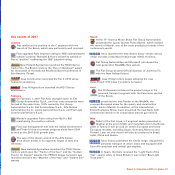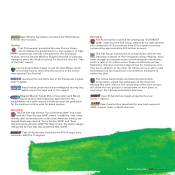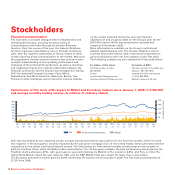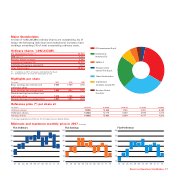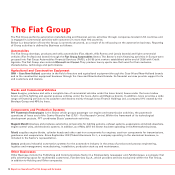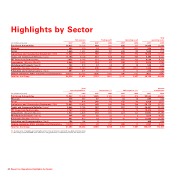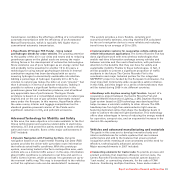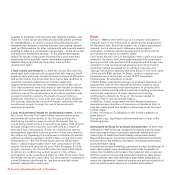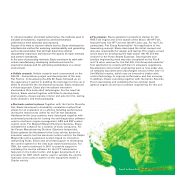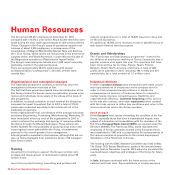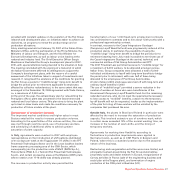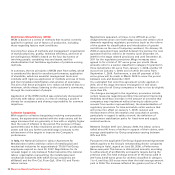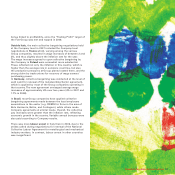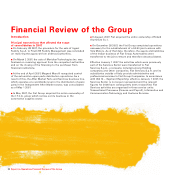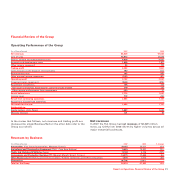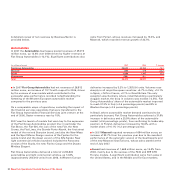Chrysler 2007 Annual Report Download - page 23
Download and view the complete annual report
Please find page 23 of the 2007 Chrysler annual report below. You can navigate through the pages in the report by either clicking on the pages listed below, or by using the keyword search tool below to find specific information within the annual report.To promote sustainable mobility on multiple fronts, the Fiat Group
has organised its research and innovation work through two
companies, the Centro Ricerche Fiat (Fiat Research Centre) and
Elasis, whose strategies are coordinated by the Technical
Committee of the Group Executive Council.
In 2007, the Group’s research and development expenses (1)
amounted to approximately 1.7 billion euros or 3% of net
revenues of industrial activities. Overall, R&D activities involve
some 12,900 people at 114 centres.
Centro Ricerche Fiat (Fiat Research Centre)
The Centro Ricerche Fiat provides the Group with effective,
innovative solutions at competitive prices, ensuring smooth
technology transfer by further increasing the professional
qualification of personnel through training. This enables the
Centre to play an active role in supporting technological growth
for the Fiat Group, its partners and the communities where they
work in such fields as motor vehicles and componentry, energy,
safe and environmentally-friendly mobility, telematics, innovative
materials and relevant technologies, mechatronics and optics.
In particular, the Centre’s work in innovative powerplants,
alternative propulsion systems and transmissions is conducted
through the area Powertrain Research and Technology headed
by FPT Powertrain Technologies, the Fiat Group Sector set up in
May 2005 which groups together all of the Group’s activities
in this area.
In addition to its headquarters in Orbassano on the outskirts of
Turin, the Centro Ricerche Fiat has four branches in Bari, Trento,
Foggia and Catania as well as a controlling interest in the C.R.P.
Plastics and Optics Research Centre in Udine, whose work
focuses on advanced research in the field of optics and plastics
for automotive lighting systems. With a staff of 865 employees,
the Centro Ricerche Fiat reached highly significant results during
the year, as witnessed by the 42 new patent applications it filed
in 2007, bringing the total number of patents held by the Centre
to over 2,200. A further 700 patents are currently pending. In
addition, the C.R.F. was awarded over 20 projects in the EU’s
recently launched Seventh Framework Program, confirming its
leadership in European research. The Centro Ricerche Fiat
cooperates with over 150 universities and research centres, and
more than 750 industrial partners around the world. This network
further strengthens the Centre’s global innovation strategies,
ensures that it can implement specific operations at the local
level, and helps it create skills and monitor its competitiveness
and growth.
Further information is available on the Centre’s website at
www.crf.it
The work of the Centro Ricerche Fiat focuses on several key areas
of technology.
Powertrain Research and Technology
The major objective in this field is to develop and apply
innovative technologies for improving powerplant
performance, cutting engine and vehicle emissions, and
boosting fuel savings. The Centro Ricerche Fiat’s most
significant accomplishments for 2007 in this area are reviewed
below:
■Multijet II. During the year, design optimization for the new
solenoid injector was completed, guaranteeing that the high
reliability targets set for this unit can be reached. The new
Common Rail Multijet II system will be introduced in
production in late 2008 on the new 1.3-liter SDE Euro 5 engine,
where it will make a significant contribution to cutting NOx
emissions without consumption and noise penalties, thanks to
its ability to manage multiple injections with greater flexibility
than the earlier Multijet system.
■Two-cylinder spark ignition engine. In the early months of
2007, bench and on-vehicle testing was completed on the first
700 cubic centimetre two-cylinder engine prototype. In tests
that focused on assessing the engine’s performance potential,
the prototype achieved a peak output of over 80 horsepower,
and even more importantly, demonstrated that it can
significantly reduce fuel consumption and at the same time
achieve low noise, vibration and harshness. On the basis of
these test results, plans have been made for a family of both
naturally aspirated and supercharged two-cylinder engines
whose displacement (900 cc) will be chiefly suitable for A
segment vehicles. These new engines will use Multiair
electronic valve control technology and will be available both
in gasoline-fuelled and dual-fuel natural gas/gasoline versions.
■Dual Dry Clutch Transmission (DDCT). Continuing the design
work on a new family of transmissions that began in 2006, the
Centro Ricerche Fiat concentrated its efforts on the actuation
and control system for the new DDCT transmission. This
Report on Operations Research and Innovation22
Research and Innovation
(1) Includes capitalised research and development expenses and those charged directly to income for the year.



